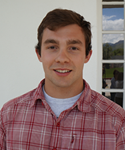iUTAH Undergraduate iFellows
Week 6 Recap
June 23-27, 2014
Allison Albert
 This week lab testing on the lysimeters continued. The testing is necessary to evaluate the effectiveness of using the ceramic porous cup lysimeters to collect data. In addition to testing lysimeters, I have been working on my iFellows poster, and looking up shallow wells. In other news, it has been decided that instead of buying different pore-water samplers to test for metals (because the ceramic ones give inaccurate metal data) we will be taking core samples of the soil and taking the soil at the desired depth, inserting it in a special test tube, centrifuging the sample to obtain the pore-water, then using that pore-water sample to test for metals.
This week lab testing on the lysimeters continued. The testing is necessary to evaluate the effectiveness of using the ceramic porous cup lysimeters to collect data. In addition to testing lysimeters, I have been working on my iFellows poster, and looking up shallow wells. In other news, it has been decided that instead of buying different pore-water samplers to test for metals (because the ceramic ones give inaccurate metal data) we will be taking core samples of the soil and taking the soil at the desired depth, inserting it in a special test tube, centrifuging the sample to obtain the pore-water, then using that pore-water sample to test for metals.
Tim Beach

This last week was mostly spent working with Adobe Illustrator. I spent some time trying to get acclimated to how the program worked, learning from blogs and Adobe tutorials. I then created a standard mapping format that would highlight the spatial data well.
Now that the format is created I'll be able to substitute the data in Illustrator pretty easily and create the Utah maps that we are looking for. I completed 2 maps in illustrator this past week and have plans to finish another handful this upcoming week.
Toby Brotherton

This week, Kenyon and I gathered more bugs from all of our traps as part of our arthropod study. We also added more pitfall traps on the Marriott Library roof, since we learned that we should have 3 pitfall traps per sampling area instead of just one (The 3 traps are placed as the vertices of isosceles triangles with 1 m side lengths). I also solidified the experimental plan for my individual lysimeter project and did more research and literature review about lysimeters and evapotranspiration. The remainder of my time this week has been spent preparing the posters for this coming Monday.

The 3 lysimeters that Toby will use to study affect of climatic factors on actual evapotranspiration
Andrew Butterfield

This week started early Monday morning with the commute to Utah Lake, the source of the Jordan River, to kick off my photodegradation of dissolved organic matter study along the Jordan River. Monday, Tuesday, and Wednesday were spent collecting, filtering, bagging, incubating, collecting, and filtering water samples at seven locations along the Jordan River. With over 128 samples collected, my time is now heavily devoted to total organic carbon analysis, and absorbance and fluorescence analysis of each sample.

Julie Kelso uses a pump MacGyvered onto a battery powered drill to filter Utah Lake into a highly scientific sterile 5 gallon cooler. This water will be used in incubations along the Jordan River

These are our light vs. dark water treatments, attached to rebar that was sunk into the Jordan River to provide natural incubation conditions

Each of the 128 samples were filtered after their incubation time in order to sterilize the sample, removing bacteria that could potentially continue to degrade the dissolved organic matter present in each sample between collection and analysis
Kenyon Gentry
 Toby and I collected another weekly sample from our four sites. We have classified some insects to the level of order but have not yet classified by family and we are waiting for microscopes; some insects are quite small. I have started to plan out my personal project, creating a low-cost flow sensor, more in detail.
Toby and I collected another weekly sample from our four sites. We have classified some insects to the level of order but have not yet classified by family and we are waiting for microscopes; some insects are quite small. I have started to plan out my personal project, creating a low-cost flow sensor, more in detail.
Adam Henrie
 This past week was spent organizing a presentation about my research. I presented to my lab group, which consists of iFellows, graduate students, and post-doctorate mentors. It was a rewarding experience because of the valuable feedback I received on the research I've participated in.
This past week was spent organizing a presentation about my research. I presented to my lab group, which consists of iFellows, graduate students, and post-doctorate mentors. It was a rewarding experience because of the valuable feedback I received on the research I've participated in.
Katy Hicks
 This week was spent working on my research question by coding Lake Powell pipeline articles from the Salt Lake Tribune for 2012 to see whether stakeholders given voice through the news media were amplifying or attenuating risks from the Lake Powell pipeline, or if what they were saying was not applicable and why. I started going through the Salt Lake Tribune's 2013 articles related to the Lake Powell pipeline to pull them so I can code them next. I have been working on a draft poster for the upcoming cohort session and iUTAH symposium.
This week was spent working on my research question by coding Lake Powell pipeline articles from the Salt Lake Tribune for 2012 to see whether stakeholders given voice through the news media were amplifying or attenuating risks from the Lake Powell pipeline, or if what they were saying was not applicable and why. I started going through the Salt Lake Tribune's 2013 articles related to the Lake Powell pipeline to pull them so I can code them next. I have been working on a draft poster for the upcoming cohort session and iUTAH symposium.
Alexis Holzwarth
 Welcome to my workstation. This is where everything happens. This week I finally got to see the cool stuff we can do with the data I have been working with. I made graphs and charts using excel to represent whatever I wanted to. The graphs are a lot more approachable and understandable than looking at a complicated (not to mention huge) database. I had a lot of fun this week. I am familiar with excel and I got to show off some cool tricks. This is really the fun part of the whole process. I also got the opportunity to explore the ArcGIS program and create some maps, which was fun and exciting as well. Suddenly cubicle life wasn't a drag! I was excited to create something new and experience the thrill of seeing the results.
Welcome to my workstation. This is where everything happens. This week I finally got to see the cool stuff we can do with the data I have been working with. I made graphs and charts using excel to represent whatever I wanted to. The graphs are a lot more approachable and understandable than looking at a complicated (not to mention huge) database. I had a lot of fun this week. I am familiar with excel and I got to show off some cool tricks. This is really the fun part of the whole process. I also got the opportunity to explore the ArcGIS program and create some maps, which was fun and exciting as well. Suddenly cubicle life wasn't a drag! I was excited to create something new and experience the thrill of seeing the results.
Jeffery D. Josephson

Claire O'Donnell

Anne Thomas
 This week I branched out with tree surveys, sampling in all four neighborhood categories-one rural house had 154 trees to count and measure, so I've had to figure out how to streamline the process. I also practiced identifying tree species with leaf samples and photos I took in the field.
This week I branched out with tree surveys, sampling in all four neighborhood categories-one rural house had 154 trees to count and measure, so I've had to figure out how to streamline the process. I also practiced identifying tree species with leaf samples and photos I took in the field.
Michelle-Kei Williams

During this sixth week in the iFellow program, I have been doing research to find studies that were previously conducted to determine what pollutants & their quantities have been found in Salt Lake City’s urban runoff. I also assisted Pratibha Sapkota in the chemistry lab, filtering 27 samples taken from the bioretention cells at the storm site & then analyzing them for their total nitrogen, ammonia, nitrate, & nitrite levels. Also, I analyzed the ammonia & nitrate levels from influent & effluent samples taken from when I ran synthetic storms last week. And lastly, I ran the last synthetic storm for the month of June & collected influent & effluent samples that I will analyze next week.




